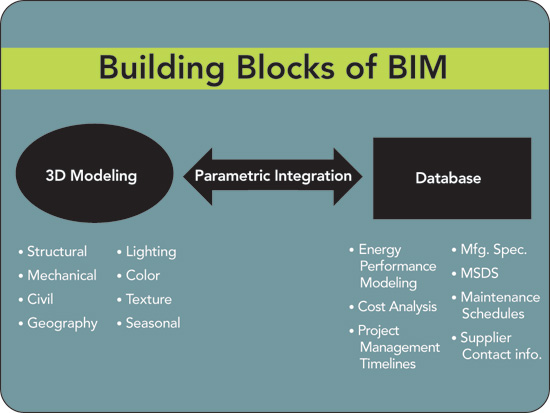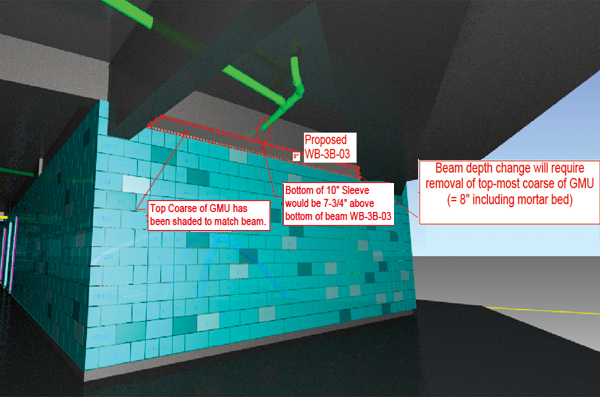BIM Comes to Masonry
Dimensional tolerance? Unit compressive strength? Type S or Type N? f'n? These are nowhere to be found. On the other hand, these dwellings illustrate the simple beauty of masonry and the ancient roots of the trade. These structures are surprisingly sound. They have high thermal mass, are termite proof, require no transportation of materials, are 100 percent recyclable, are locally mined and manufactured. In fact they surpass even our best efforts at being “green” and sustainable. One man can mine, manufacture, deliver, and install all the necessary components to build these structures—a remarkable feat.
Since its inception thousands of years ago, masonry has in many ways not changed. It is still practiced today in exactly the same form that it began so long ago. Even at its most basic state, masonry is still a very effective means of providing shelter and security for people all over the world. At the other end of the spectrum is masonry in the U.S. In addition to cost, aesthetics, and durability, our projects must meet standards for energy performance and sustainability, and they must be technology friendly. Those involved with masonry products today may likely spend their time with high-end computer hardware, the latest in software developments, intricate algorithms and analytical methods. The push is on to develop something that has never occurred to those builders of mud huts but could prove invaluable in today's world demanding complex projects—3D models of masonry buildings to advance the art of BIM for masonry.
Building Information Management (BIM)—What Is It?
As most architects know, BIM is a process that involves the generation and management of digital representations of physical and functional characteristics of places. Building Information Models (BIMs) constitute files, which may incorporate proprietary data and formats. These files are exchanged or networked to facilitate decision-making about a project and its design. BIM extends the format to 3D, incorporating the three primary spatial dimensions of width, height, and depth with other dimensions, such as time and cost, taking the information to a fourth and fifth dimension. BIM is object oriented, and in order to understand BIM, an understanding of the object being modeled is necessary. Unlike CAD, which represents elements with lines that define its geometry, BIM creates smart objects that contain several levels of information, or parametric data, including geometry, material properties, color and texture, cost, source and distribution information, and manufacturer. Each element in the BIM model “knows” how it relates to other objects and to the design in general.
Designs are represented as combinations of objects, or assemblies that can be simple or very complex, and can be analyzed as systems or according to cost. Because BIM defines objects as parameters and in relation to other objects, if an object is changed or modified, related objects will automatically change as will the associated cost estimates as well as material tracking, ordering, and many other attributes.

Image courtesy of Oldcastle® Architectural
Because each member of the design team from architects and engineers to contractors and owners adds discipline-specific data to the single shared model, information losses are reduced and a more detailed database is created about a complex structure. Use of BIM, then, extends beyond the initial planning and design phase of the project, to have value throughout the building life cycle, and to support such project stages as construction management, project management, facility operation, and beyond. Early adopters are enthusiastic and confident that the use of BIM will enhance a variety of functions including improved visualization and productivity; better coordination of construction documents; increased information about specific materials and quantities for estimating and bidding; dramatic savings in overall project schedule and costs. BIM advocates also point out that most of the data needed for building energy performance analysis exists and that building energy simulation is feasible from an accuracy, time, and cost standpoint.

Image courtesy of CAD BLOX LLC/Suffolk Construction
Detailed masonry models are providing meaningful data in the BIM environment.
That said, some industries are more BIM-compatible than others. In terms of structural building materials, the main focus has been on incorporating steel and reinforced concrete into BIM software. For years, structural steel and cast-in-place concrete have had software with 3D capabilities and substantial design information that has made it easy for BIM software developers to build on. Likewise, several BIM tools have been developed for wood and cold-formed steel. Why not masonry? Arguably, the reasons stem principally from the intricacy of masonry products themselves and the endless possibilities to combine these products into complex arrays.
The BIM-Masonry Challenge
One of the reasons masonry has not been included in BIM software is the sheer complexity of the material.
For starters there is the problem of managing the large number of units possible in a commercial masonry project. A block job may have several hundred thousand units and a large brick job can have more than a million units. Each unit has a unique location and orientation in the model, making unit model building a huge labor task. A variety of bond patterns are available to arrange the units in the building and sometimes several patterns are combined. Beyond this, many options exist for material and several are typically combined in a single job. There may be natural stone, manufactured stone, clay brick, concrete masonry, and within each option there can be many colors and textures, making the models even more complex. If that weren't enough of a challenge, an additional layer of complexity is added by shape variation. Consider a very simple case of a wall of 8816 standard concrete masonry units all in the same color and texture. Within that product there may be 75 percent solid units, bond beam units, open end units, double open end units, solid bottom units and on and on it goes. Finally, additional layers such as making the job ground face or adding bullnose corners compound the problem. One can easily appreciate how much information must be tracked in a quality masonry model to get useful data. Each of the layers of complexity described above impact cost, so unless they can be tracked in the model, accurate cost data cannot be generated.
The dynamics of modeling are such that it is relatively easy to model materials that represent a small number of dissimilar objects regardless of complexity. Consider a revolving door which likely has only a few instances. It is also not difficult to model a very large number of homogeneous items as is the case for hundreds of thousands of roof tiles. But for masonry models which have both large number and great variation, the task becomes exponentially complex—especially for architectural masonry.
Challenges abound in incorporating masonry into BIM, and there are no easy answers, and no short cuts, just as there is little value in a model unless it is high quality and can take into account the complex layers of data required. It is not difficult for BIM designers to generate data, even for masonry. The real challenge for modeling masonry is quality data. While a stretcher—a basic unit in the field of a wall—may have a given cost, a corner unit of the same material can be three or four times as expensive in some architectural applications. Accurately accounting for these variations in product is essential to generate useful Quantity Takeoff (QTO) data for masonry.









